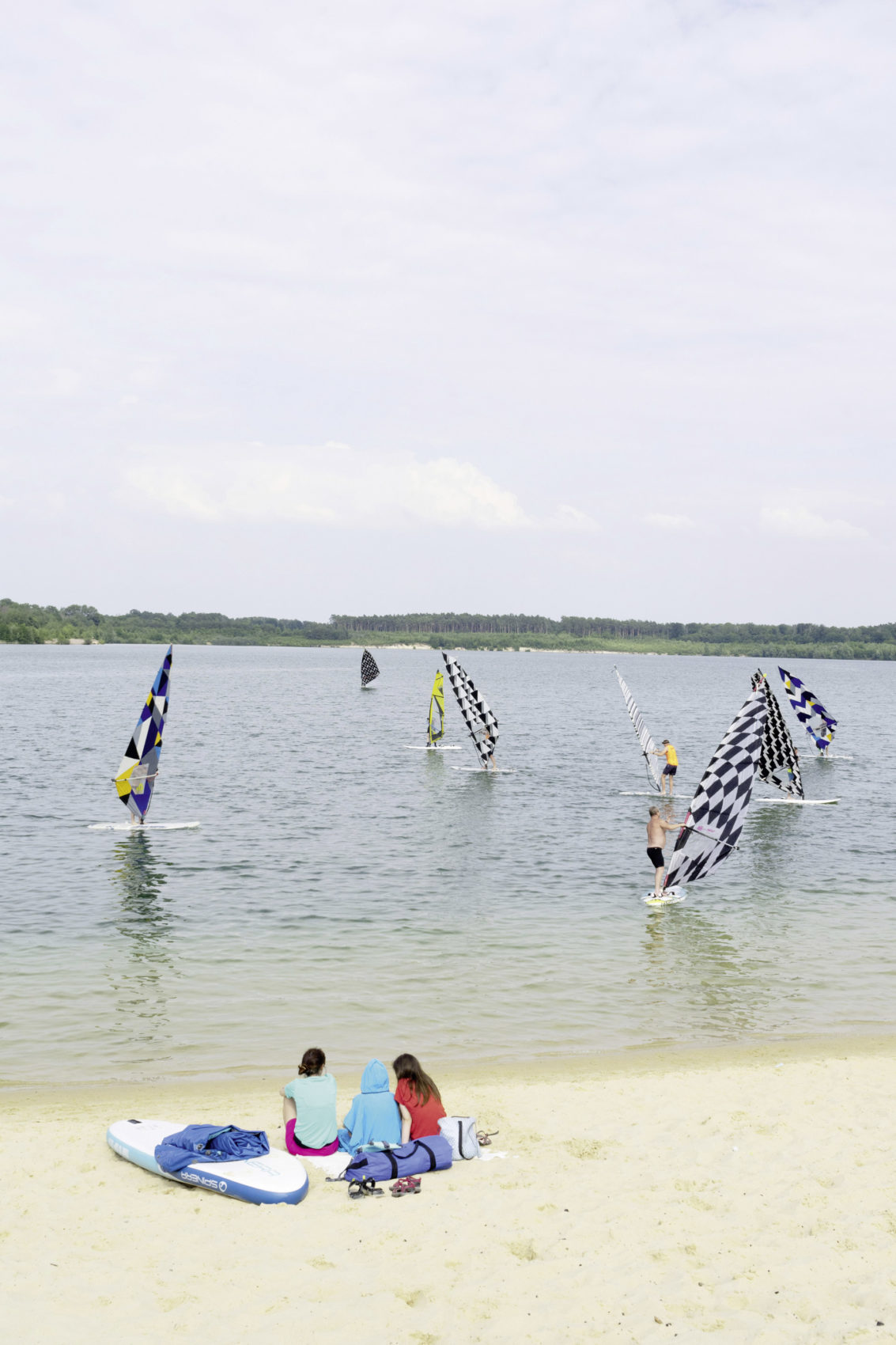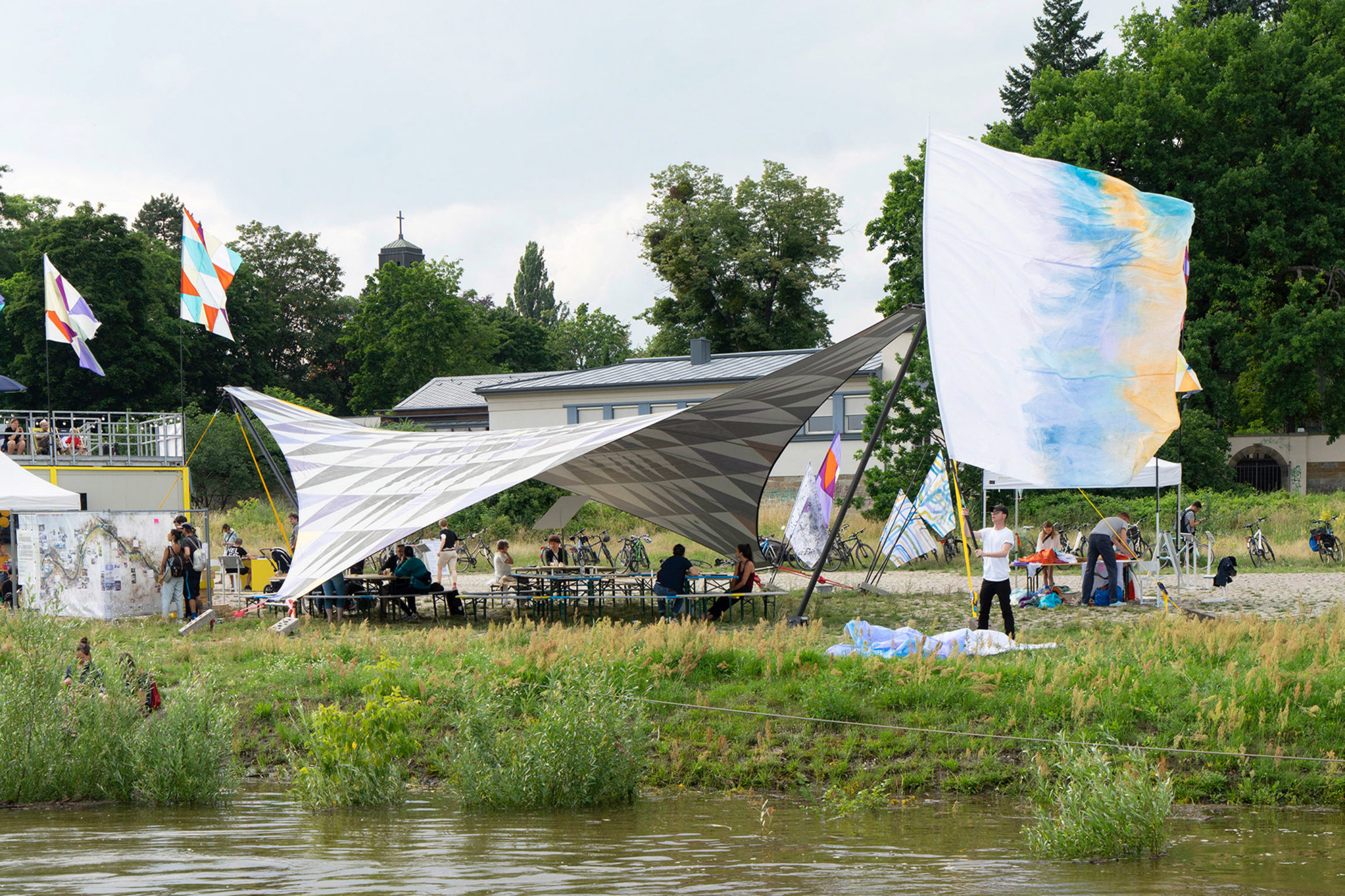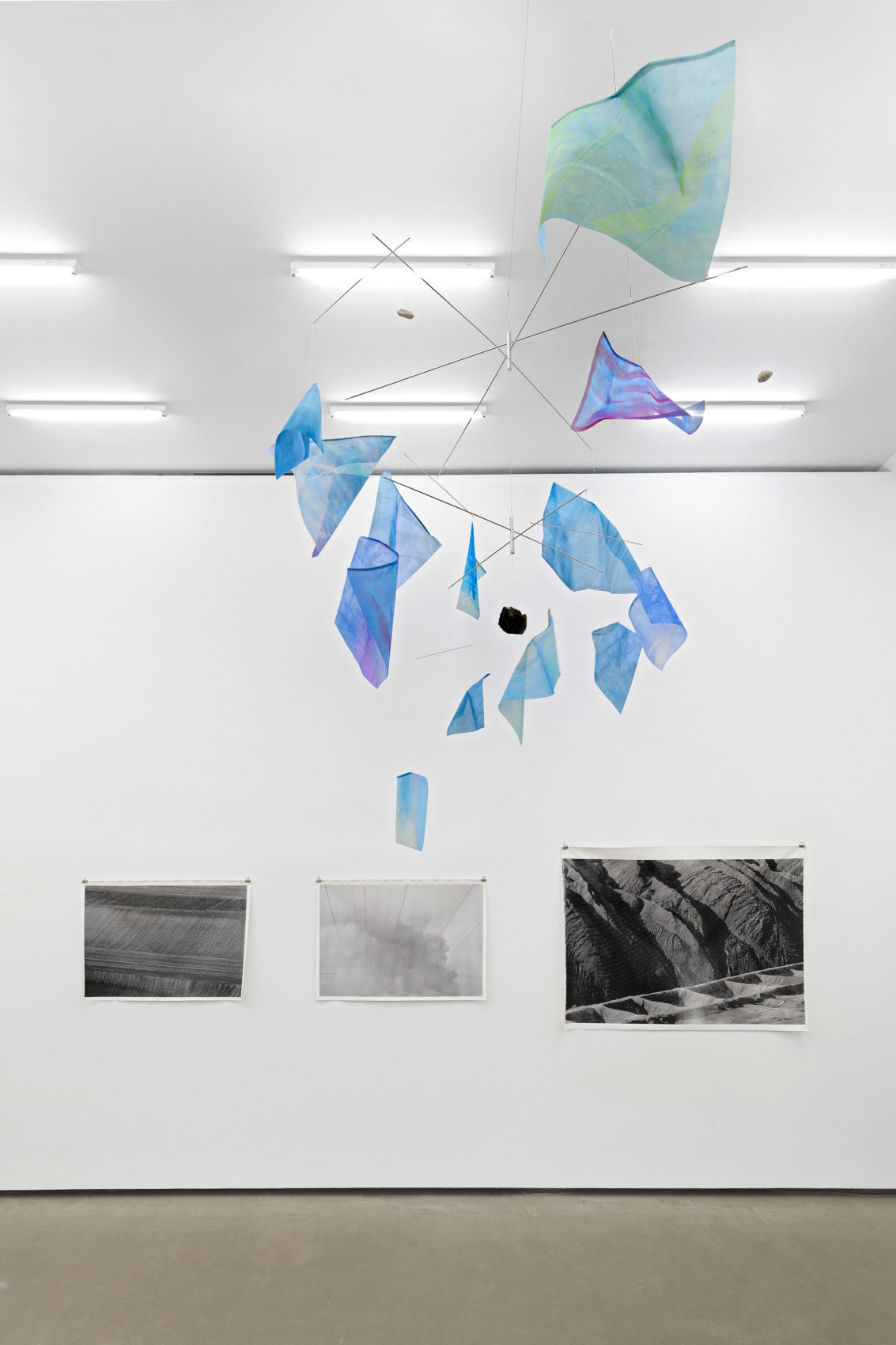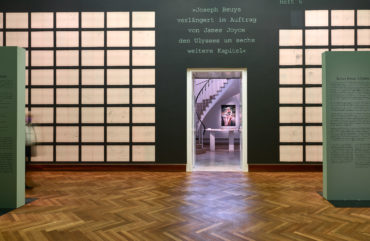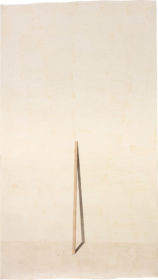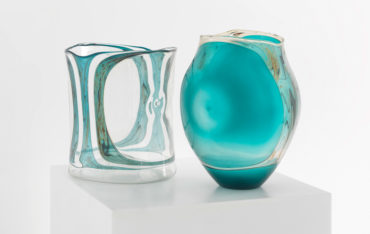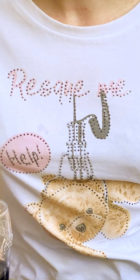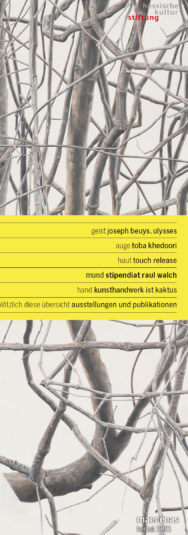scholarship-holder Raul Walch
Moving between installation, sculpture, painting, textiles, and photographic documentation, Raul Walch’s artistic practice continually investigates the social potential of artworks. Reflecting on the limits of a static studio practice, the Frankfurt am Main-born, Berlin-based artist expands his research through travel, often establishing collaborations with local communities in situations where a mutual interest is established.
Textiles has long been a focus of Walch’s research, which he has used to create an ongoing series of temporary pavilions that provide delicate, floating spaces of protection. A direct interest in the destruction and deformation of our natural environment has been reflected in several projects carried out in recent years. A year ago, at the height of the pandemic, Walch presented the work Ocean Nine – a gigantic mobile installation, made of various synthetic fabrics, found footage, tent poles, wire, ropes and agro-textiles – as a contribution to the exhibition Zero Waste at the MdbK in Leipzig.
Alongside his artistic practice, Walch taught the Public Art programme at Bauhaus University Weimar from 2019 to 2021 and is now co-initiating the academic programme for the Floating University in Berlin, a social cooperative project funded by Urbane Praxis Berlin, which was established by raumlaborberlin in 2018.
In July 2021, he talked to Berlin-based critic Chloe Stead about his most recent projects, including Owned by Others, which was made possible through his 2019/20 Hessische Kulturstiftung travel scholarship to Namibia.
Chloe Stead You’re currently part of the exhibition Park Platz at the Berlinische Galerie, which takes place, as the title suggests, in the museum carpark. What can you tell me about your contribution to the show?
Raul Walch In some ways, being able to work outside of the museum has been more inspiring to me than working inside it. As an artist who focuses on the public domain, it’s interesting to see how the pandemic has encouraged museums to try out some more unconventional formats. I know from my experience that it is often difficult for them to step out of their traditional working methods.
I was invited to develop a project based on the three flagpoles that are installed outside the museum. I replaced the usual flags of the Berlinische Galerie with three new painted pieces from the series Heat Flags. The title, which was inspired by heatmaps, derives from the fact that colors are often associated with temperatures but can also symbolize changes in elevation or other gradients represented by the entire color spectrum. And as usual with the display of flags, three different scales are considered: regional, continental and global. Alongside this intervention, I’m also working on a connected project made in collaboration with members of the local community.
Stead What will that collaboration look like?
Walch Well the project has been delayed several times due to Covid restrictions, but I’m working with a nearby refugee camp, young glass engineers enrolled in a vocational school next door and a neighborhood initiative based a few blocks away from the museum. Together, we will design and make three curtains that will act as moveable partition walls for the exhibition’s temporary pavilion, which will eventually hold a series of workshops, talks and community events.
Stead One of the things that is so interesting about using fabric as a medium, especially in public space, is that it moves according to the elements. Wind is also a vital element of Assembly (2021), an interactive kinetic sculpture that you produced for the exhibition Ruhr Ding: Klima at this year’s Urbane Künste Ruhr. The exhibition, which is dedicated to art in public space, took place in four locations, including Silbersee II, a popular artificial lake in the German town of Haltern am See. How did you react to this unusual setting?
Walch The basic idea was to create an island within the lake affixed with sail that moved according to the direction of the wind. On the beach side, people would naturally try to and sit as far apart as they can from their closest neighbor, but on the platform, there was no choice but to come together, so this idea of sharing space and time became more prominent. It was a big challenge for me because I’ve never created such a complex floating structure before. The tricky bit was that it had to be flexible enough to move gently with the wind while still holding up to 40 people.
Stead How do you judge the success of participatory projects like this one? Is it important for you that your projects connect with a wide variety of people?
Walch The success of the work at Urbane Künste Ruhr is that it was well received by the local public. When you do exhibitions in unconventional spaces, you have to be aware of the differences in the backgrounds of the visitors who will encounter the work, much more so than in sheltered art spaces. It is very important for me to recognize this challenge and use an open and positive language that brings people together and emphasizes what unites us, rather than highlighting what divides us. Alongside Assembly, I also worked with a local windsurfing association to create a series of painted sails and surfboards that members could “perform” with, which was a very exciting way to connect to one of the surrounding realities most daily connected to the lake and its vitality.
Stead These pieces are part of an ongoing series of works you titled Spherical Semaphore, which refers to a method of communicating with flags used by sailors. Many of your fabric works, including this one, feature brightly colored geometric patterns that seem to want to transmit information to their audience. What is your interest in working with these forms?
Walch This method of working developed from color codes that already exist in public space. You often have the situation where a nation can essentially depict its territory within a three-color pattern. I was drawn to the fact that if you change these patterns without making them completely abstract then people still try to read them. I’m also interested in optical phenomena. For the project with the windsurfing club, for instance, I used a different pattern on each side of the sail, which meant that when the surfers did a trick you almost lost track of where they were on the lake.
Stead Both of these projects took place in Germany, but in a previous interview you said that you “research through travel, absorbing new places and topics every time.” In the past, this “search for the unknown,” as you call it, has involved initiating projects in cities such as Addis Ababa, Seoul, and Tokyo. How has living under travel restrictions over the past year and a half affected your practice?
Walch For me, traveling for exhibitions or residences has been a way of learning what was unknown to myself as well as getting closer to other cultures and learning to respect cultural differences. But with the start of the pandemic, I stopped flying – the furthest trip I made was to the Alps – and it definitely led me to reflect on my own behavior when it comes to travel. I realized that it’s possible to tackle global topics in a local setting.
Stead When working on community-based projects, whether home or abroad, there is always the danger of othering or exoticizing the very people you want to work with. How do you avoid this tendency when engaging with communities that are not your own?
Walch It can certainly be exploitative to use the conditions of a space as your stage. But one important step can be to relate the new location to the environment or society that you come from. One example of this is a project I did about plastic waste from the enormous greenhouses in Southern Spain, which I tried to bring back to consumerism in Germany.
Stead Alongside making artwork, you are on the board for bbk Berlin, an association representing the interests of the city’s artists, and you also you co-initiated the anti-far right platform Die Vielen (the many). How do you see these political activities in relation to your artwork?
Walch It can be difficult, but I try to not entangle my artistic activities with my activist projects. Sure, there is a relation but, when it comes to my artwork, I don’t try to educate an audience. With my activist work, however, I’m free to take a more direct approach, which is perhaps less poetic, abstract or mystical. It can be a release for me to do a project about voting rights, for instance, because then it’s about reaching as many people as possible. Artworks don’t have to necessarily reach such a big audience to be meaningful. As I mentioned earlier, one-on-one contact is enough for me, and I feel much freer to speak for myself with my artistic work. Politics, on the other hand, is always a collective effort.
Stead As the last topic, I wanted to ask you about Owned by Others, an initiative inspired by several trips you took to Namibia in 2019 with travel funding from the Hessische Kulturstiftung.
Walch I went to Namibia twice, and wanted to go a third time, but I wasn’t able to because of travel restrictions. Instead, thinking about the Germany’s colonial history and the continuation of these power structures, I developed an ongoing project, together with cultural scientist Lutz Henke, about Berlin’s Museum Island. We then addressed other topics of interest to us there, such as the inadequacies of public space in Berlin’s Neue Mitte. Owned by Others unfolded in the fall of 2020 through a series of interventions over the course of five months: artists from Baghdad, Guatemala City, Addis Ababa, Tijuana, Dakar, and Berlin were invited to exhibit works that investigated traditional symbols of power and the evolving landscape of the city, uncovering narratives, places, and artifacts from Berlin’s Museum Island. The invited artists took a critical look at what is happening there and at the Humboldt Forum, which features the rebuild façade of the former Royal palace, but from my point of view, does not sufficiently take into account the horrors of German colonial history.
Stead What has the reaction to this project been? I can imagine that it ruffled some feathers…
Walch There was a lot of interest in the project by artists and activists, but due to the pandemic we only worked with very small groups. Instead of big events, we used a map-based website and public archive – www.ownedbyothers.org – as well as weekly gatherings in our project space at Spreeufer 6, which is in the Nicolai-Viertel, opposite the Humboldt Forum, to attract some attention. In the fall of this year, we plan to restage some of the artistic works again as well as show a few new productions.
Owned by Others has already had a positive effect. Our project space is now being used as a location for decolonial action that brings together different initiatives and will let certainly more than just feathers fly.
